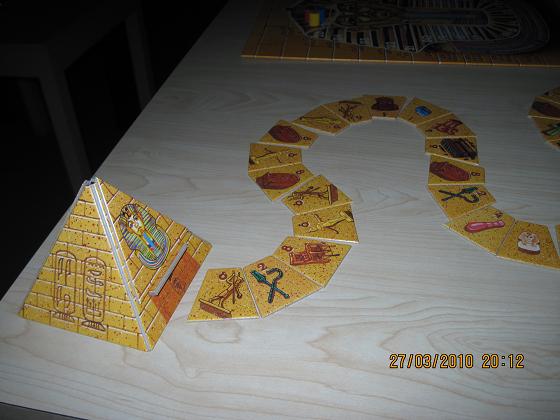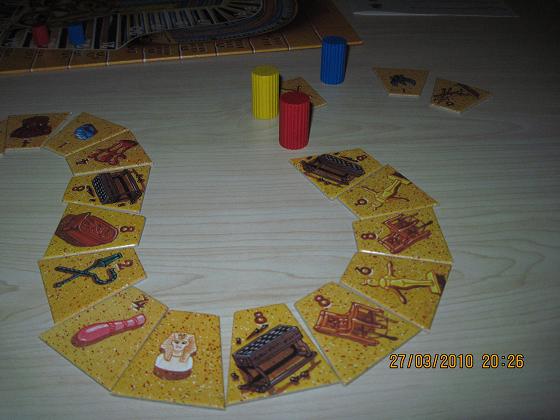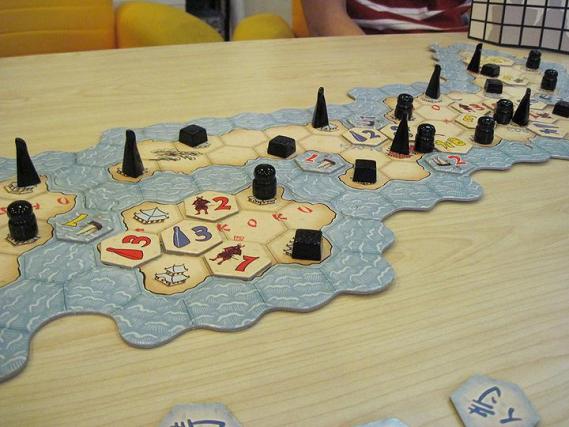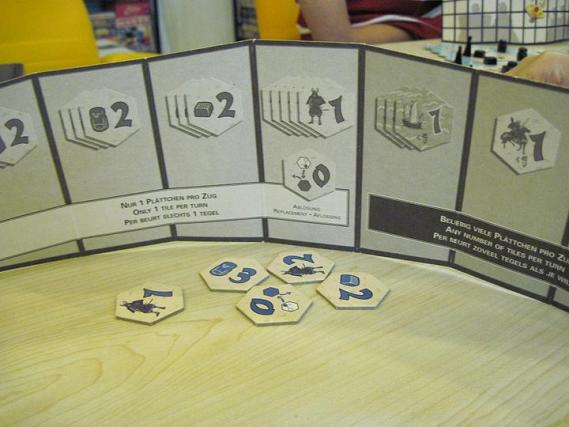
We played Tutankhamen a while back and Samurai only recently but since both games were designed by Reiner Knizia, I thought I’d cover both of them in one post. Though I’d consider both games to be fairly lightweight, Tutankhamen is the simpler of the two by a fair bit. The game has a rather ostentatious Egyptian theme and Sean’s version comes with a cardboard pyramid that you put at one end and a series of trapezoidal tiles that you link together to form a path that leads to the pyramid.
These tiles represent various artifacts that the players are out to collect and the object of the game is to collect sets such that you have more of the same type of artifact than the other players. Everyone starts with the same score at the beginning of the game, which varies according to the number of players, and the object is to get to zero. Once all artifacts of the same type are gone from the path, you discard points equal to the value of the set, which is the same as the total number of tiles of that type in that game, provided that you have more of that type than any other player. The game is over when all players reach the end of the path.
Players collect tiles simply by moving their token from the beginning of the path to the tile they want. There’s no restriction on how far you can move. You can even move right up to the pyramid on your first turn if you want but then you’d lose badly. The interesting twist is that tiles that all players have moved past and therefore declined to take are removed from the game. As Sean demonstrated in our game, if you already have more of a certain type of artifact, causing them to be removed in this way is also a way to solidify your lead.

In addition to the normal artifact tiles, there are also wild card tiles which can be used to represent any artifact provided that you already have one of that type and a special tile that lets you steal a tile from an opponent, but also lets them discard a point. The first person to reach the pyramid also gets the tile placed on it to use as a wild card. The first impression I have is that the theme is completely superfluous and unrelated to the rules. In fact, I’d argue that the components are over-produced and even distracting. It would be just as easy to play this game using a deck of cards and choosing more familiar symbols would likely make it easier to differentiate them into sets.
Still despite the simple rules, I think it’s quite a clever little game. Since all the tiles are uncovered, it’s a game of complete information and aside from the placement of the tiles at the beginning, there’s no randomness at all. So it’s a bit surprising that there’s still enough in this to make for some painful decisions such as whether to go for the high value artifacts knowing that it will be difficult to compete with the other players to have more of them or to go for the low value ones because it’s easy to get a majority of them.
Samurai is a bit similar in that the objective is also to collect sets of objects. In this case, there are only three types of objects, represented quite incomprehensibly as hats, rice paddies and Buddhas, and they are scattered across a map of Japan composed of hexagonal spaces. The objects are collected when all of the land hexes around them are filled with tiles laid down by the players. These tiles represent the influence that each of the players can exert. Whoever has the most influence gets the objects in the middle of the tiles. If there is a tie, the objects are removed from the game entirely.

To complicate things further, there are many different types of tiles in the game. At the start of the game, you draw five tiles to use from your pool and replenish back up to five at the end of your turn. Most of the tiles can exert influence only on one of the three types of objects and will have the picture of the appropriate object printed on it. Tiles with a samurai on them are wild cards which can exert influence on any type of object. There are also ship tiles that can only be played on water hexes and can exert influence on any type of object, but it isn’t necessary to fill the water hexes around an object in order to be able to collect it. All of these tiles have a number printed on them to denote the strength of the influence they exert.
In addition, there are a couple of special tiles. One of them lets you retrieve one of your tiles that you’ve already played on the map so that you can reuse it later. The other one is more insidious as it allows you to exchange the positions of any two objects on the map. Normally you can only play one tile during your turn, but there are a few tiles with a special character on them that no such restrictions so you can play as many of them as you want to pull off some surprises.
Finally the scoring system is somewhat unusual and explaining it is going to be convoluted. The game ends when either all of the objects of one type have been taken from the map or four of any type of objects are removed from the game due to ties in influence. Then, you check to see if any player has a majority of objects in at least two types. If so, that player wins. If not, then only the players who have majorities in one type of object are in the running and must count up the total number of all other objects not in the category they have a majority in. Whoever has the most, wins.

Once again, this is a game with a relatively simple ruleset but it’s obvious that there’s even more strategy involved here than in Tutankhamen. The map is designed in such a way that many of the hexes in which you can place tiles can exert influence over objects in two different places. Some places also start with more than one object in them so that they are natural focal points to be fought over. There are so many possibilities that I fell victim to analysis paralysis but still did badly as I struggled to choose between placing tiles in efficient spaces where they could exert maximal influence or placing them to surround and grab objects quickly.
It’s interesting to see that these two games by the same designer show so many similarities. Both have themes that are feel pasted on though at least in the case of Samurai placing samurai and boat tiles on a map of Japan feels more substantial. Both are games with relatively simple rules and little randomness that nevertheless involve some interesting strategic thought. Samurai is the better game of the two with more long-term potential but I think that both are fine games.
I do note however that while I quite like these Knizia games, I don’t feel the urge to obsessively play them over and over again as I feel tempted to with games like Agricola and Le Havre. Even other small games like Dominion or Race for the Galaxy feel like better candidates for repeated plays even within a single day. Instead, Tutankhamen and Samurai feel like good games to pull out once in a while but there’s not really enough variation in them to make me feel like wanting to replay them often.
3 Responses to “Tutankhamen / Samurai”
Thanks for the reviews. I wonder if you feel that the theme is Samurai is more relevant simply because of the added complexity of the game. Understandably, a map of Japan and using samurai and boat tiles contribute something, but do the core mechanics really stress the game theme at all?
I myself own both Ra and Through the Desert, which are both Reiner Knizia games. In my opinion, both are very fun games. They do run into the usual “pasted-on theme” criticism, though I’d say that Through the Desert does demonstrate more concern with making the theme relevant to design aspects than Knizia usually gets credit for.
In case you don’t know the games, Ra is an Egyptian-themed auction game where players gather various tiles representing Pharaohs, monuments, culture/civilization, and so forth, each of which translate into points. Get the most points and you win. While the theme – notably just as ostentatious as what I see here in Tutankhamen – is mostly irrelevant. The addition of “disaster” tiles that can destroy elements of your civilization does add some flavor. But why you’re bidding on those tiles (or even bidding at all, and doing so in competition with one another at that) remains a mystery.
Through the Desert is a bit reminiscent of Go (and in fact Samurai which is mentioned here as well) in that you’re placing pieces with the intention of surrounding as much space as possible in order to “grab territory” and win. There are little landmarks worth additional points (these are “oases”) and they can be grabbed either by surrounding them or by simply placing a piece next to them. The trick is (not unlike Samurai) that you have five caravans being built concurrently and can only choose two pieces to place at a time. The pieces you place have to be adjacent to a previous piece that matches it in color (you have 5 different colors, each representing one of the caravans). Of course, you have to manage other players’ competing caravans as well. Again, the Arabian/Desert theme is a bit superficial, though the design mechanic of placing pieces (camels) adjacent to one another to form a caravan actually does a good job of representing the desert theme effectively.
That being said, both games are very fun and have a good element of replayability. One other thing I particularly like is that the number of players involved scales well. Through the Desert is made for up to 4 players, and plays well with either 3 or 4. Ra plays well with 3-5 (four or five being best), and is intended for up to five players.
As a regular war/strategy gamer, this is something I can definitely appreciate.
I do think that Samurai’s added complexity makes its theme feel more alive. It’s hard to hang any theme at all on a game that’s too simple. Below a certain threshold of complexity, the abstractness of a game’s rules just becomes too naked.
I’ve played Through the Desert before, but did rather badly as the game relies rather heavily on color-coded caravans and I have a slight color blindness. I can tell the difference between the hues if I squint hard enough, but trying to efficiently process all that visual information is beyond me. I do like the comparison to Go, which I think is truer for Through the Desert than Samurai.
I’ve yet to play Ra, though I’m sure that Sean, the owner of the cafe I mentioned earlier, will endeavor to remedy that in short order.
Now you’ve got me thinking about whether or not theme is necessary at all in many simpler games. After all an ordinary deck of playing cards has no theme at all but there are plenty of good games that you can play with it without having to pretend that you’re doing anything other than playing by an arbitrary set of rules.
I can see how Through the Desert would be a pain. In fact I have a couple of friends who won’t play the game for that very reason. I simply don’t understand why there was a decision to use pale pastel blue, pale pastel purple, and pale pastel green all in the same set of pieces. Not to mention that the orange and yellow look pretty similar too. Apart from making the pieces look like delicious fruit snacks, it begs the question of why plain colors like solid, bright red, blue, green, yellow, etc were not chosen.
Have you ever heard of a company called Cheapass games? They make Kill Doctor Lucky, if that sounds familiar. I think they fit pretty well into the category of “theme isn’t necessary” for their games. Their credo is that a game can be made much cheaper if the components are stripped down to bare necessities. They basically sell cheap paper cards and game boards and tell you to go find pieces, dice, etc on your own to play their games. While their intent isn’t to avoid engaging players in a theme, this is a byproduct of playing games with random pieces from other board games or junk you have laying around.
That being said, they have some clever writers who add in flavor text here and there, which makes the game pretty fun. Also, since the writers have a noticeable and entertaining tone, it does set up a bit of a tongue-in-cheek murder mystery type theme.
Interesting how words can replace decoration in that example.
Leave a Reply